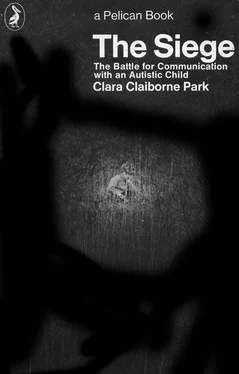Yet at the same time we were determined not to abandon Elly in the isolation she found so congenial. To treat so marginal a child as retarded would itself ensure that she would become so; if she were in fact retarded it would make her worse. Once I had been glad of her self-sufficiency; now I must fight it. She must be approached, played with, taken places, drawn into the family. She had liked being alone, she had spent hours in her crib, sleeping, bouncing, laughing, rocking, rocking, rocking. All that must now be at an end. little as she appeared to want our company, she would have it. She might be content with the rise and fall of a chain; I must find better toys and try to lead her through them to more complex experiences and skills.
It would have to begin with movement and the sense of touch. Compared to touch, hearing and sight are indirect, remote, far less central to the living organism. People can exist without sight or in total deafness. They can be so preoccupied that they neither see nor hear the world around them. Touch them, however, and they will come to themselves. Touch is the most directly apprehended of the senses. The body’s response to things that touch it ceases only with death.
Through sound I could achieve no contact with Elly. Her sense of sight was hardly more promising — she looked at me sometimes, more often than at anyone else, but except in exceptionally favourable situations, as when I greeted her in the morning, she ignored me too.
Unless I came very close. When I touched her, she noticed that. And although she did not seem to hear or see, her small legs and arms and fingers moved. She could inhibit her senses but she could not entirely deny she had a body.
It was in her motion, in fact, that the discrepancy between what she did and what she gave flashes of being able to do first showed. I remember a day when a friend brought her toddler, a little older than Elly, to visit. Johnny had been walking for months. He had rushed into it, as many babies do, before he was physically ready, he had wanted to so much. He had stumbled fallen, but he had walked. We had both laughed when, able to walk but not yet to sit down, he had collapsed from a standing position on to his bottom with a thump. Elly could stand up too. She too sat down, but it was no ungainly flop. As we watched, she lowered herself, legs gradually bending through a squat, into a sitting position, in an exhibition of controlled grace unusual in any child of that age. My friend exclaimed what we both thought: ‘Why Elly, you fraud!’ This the child who couldn’t walk? Obviously she could walk. She would walk as soon as she wanted to put one foot in front of the other. Yet it was months before she did walk.
It was the same with using her hands. She had begun to feed herself with her fingers at about fifteen months, but she did not use a spoon We had done the usual tricks, we had kept a small spoon available, we had provided tempting foods that required it, but Elly had ignored them. One day she had finished her meal and been lifted down out of her high chair, while the family continued eating. Suddenly Elly, hardly big enough to reach the table, grabbed a large, awkward spoon and conveyed into her mouth a large dollop of my dessert. It happened so fast we barely saw it. Then she was gone. We tried her again next day. Her hand went limp. Not only could this child not feed herself, she couldn’t even hold a utensil.
There was, of course, no point in talking to her. A child who doesn’t respond to ‘Elly, here’s a cookie,’ will hardly understand If you don’t pick up that spoon you won’t get any ice cream Yet even pigeons can be shown that rewards are conditional upon performance; the same methods that teach rats to run mazes might have been used to get Elly to hold a spoon.
Today children like her are learning, by means of the behaviour modification techniques developed by psychologists like Ivar Lovaas and Frank Hewett at the University of California at Los Angeles, not only to feed themselves, but to respond to people, even to speak, as the desired behaviour is analysed into stages and every centimetre of progress rewarded to encourage the next small step towards the goal. Today these techniques are taught to parents. But when Elly was two experiments with reinforcement therapy had hardly begun. She was seven before I even heard of them.
It did not take long to learn that to put Elly into situations of extreme pressure was not only lacerating but useless. I have mentioned that she learned to crawl upstairs at seventeen months, and then forgot. After many months — it was after she came home from the first trip to the hospital — she learned again, and with some help she learned also to crawl down. But she did not learn as other children do, a skill to be extended, applied in new situations with a feeling of mastery and pleasure. She could crawl up and down our main staircase. Not our third-floor stairs, however, and not any staircase in a neighbour’s house. One day — she was just past two — we carried her halfway up a friend’s stairs and marooned her. I stayed at the bottom, smiling encouragement. She understood the situation at once, she who understood so little. She began to cry, with a kind of crying very rare for her, for though she might fret, or cry loudly if hurt, she did not cry much or long. This was a hard crying to listen to — lost, furious, totally committed — a crying that came up from the inside depths we never reached. We let it go on for twenty minutes. Then we carried her down. What would she have learned if we had left her there? Nothing, I think, except that we were willing to treat her with inconceivable violence. We could not have left her there. I think, I really think she was ready to stay there till she died.
But she did want to come down enough to cry about it. That itself was rare. Her detachment usually provided her with better armour. In almost all situations, the weakness of her desires was there working for her, against us. The rat wants the flavoured pellet, the pigeon wants the corn. What did Elly want enough to meet any conditions for getting it? Not a cookie, not a toy, not a ride in the car. A baby who like a Zen adept acquires the knack of inhibiting its desires approaches something akin to the Zen satori. Serene, in perfect vegetative equilibrium, it can be content to do nothing at all. When a creature is without desires the outside world has no lever by which to tempt it into motion.
So again and again it was as if she could but wouldn’t. That, of course, was the source of the doctors’ uncertainty. Those vigorous legs, those exquisitely controlled fingers sifting the links of her chain became weak and useless when confronted with any imposed task. And what was an imposed task? To climb, to reach, to walk — all the activities other children spontaneously throw themselves into in their delighted desire to learn and grow. Elly seemed strong. But between her and any normal development lay this terrible weakness, a weakness that was no less real because it seemed to lie not in the muscles but in the will.
Who knows what is willed and what is not? Who boasts he can read minds — least of all a wordless baby’s? In humility I can only say that Elly’s weakness seemed as if it was willed, in full realization of the difficulty of believing it. It is a little too much to swallow — to accept that an infant can assess its situation as we have all seen frightened grownups do — and decide that anything is preferable, even total withdrawal, to the risks of activity and growth. It is as if... As if. Again and again we used this formulation, as we searched out explanations of our child s strange contradictions. As if — yet we could not and cannot be sure. We cannot help interpreting. The words as if must function to remind us that we can be sure of no interpretations.
Читать дальше












